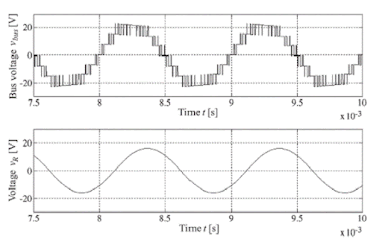ABSTRACT:
This paper presents the
modeling and simulation of an adaptive neuro-fuzzy inference strategy (ANFIS)
to control the speed of the switched Reluctance motor .The SRM control is thus
a difficult to be in use in the nonlinear applications, particularly in the
control of speed in automobiles. The Neuro-fuzzy system incorporates the
advantages of both neural-network and fuzzy system. This controller is great
additional effectual than Fuzzy logic and neural network based controller,
while it has the ability of self-learning the gain values and acclimatizes
accordingly to situations, thus accumulating more flexibility to the
controller. A complete simulation, well-designed to the nonlinear model of Switched
Reluctance Drive was premeditated using MATLAB /SIMULINK.
KEYWORDS:
1. SR Drive
2. ANFIS
3. ANN
4. FLC
SOFTWARE: MATLAB/SIMULINK
Fig.1.Block Diagram of ANFIS Controller for SRM Plant
EXPECTED SIMULATION
RESULTS:
Fig.2: Response of the speed control of SRM using FUZZY, ANN and ANFIS with speed Command 3000 RPM under no load conditions.
Fig.3: Response of the Speed and Torque Control of SRM using ANFIS with Speed Command 3000 Rpm under no load conditions.
Fig.4: Response of The Speed and Torque Control of SRM using Fuzzy, ANN and ANFIS with Speed command 4000 rpm.
Fig.5: Response of the Speed and Torque Control of SRM using ANFIS with Speed Command 4000 rpm.
Fig.6: Response of the speed control of SRM using FUZZY, ANN and ANFIS with speed Command 3000 RPM under load ConditionsFig.7: Response of the speed and torque control of SRM using ANFIS with speedREFERENCES:
[1]
J. P. Lyons, S. R. MacMinn, and M. A. Preston, “Flux/current methods for SRM
rotor position estimation,” in Proc. IEEE Industry Application Soc. Annu.
Meeting, vol. 1, 1991, pp. 482–487.
[2]S.
R. MacMinn, C. M. Steplins, and P. M. Szaresny, “Switched reluctance motor
drive system and laundering apparatus employing same,” U.S. Patent 4 959 596,
1989.
[3]
M. Ehsani, I. Husain, S. Mahajan, and K. R. Ramani, “New modulation encoding
techniques for indirect rotor position sensing in switched reluctance motors,”
IEEE Trans. Ind. Applicat., vol. 30, pp. 85–91, Jan./Feb. 1994.
[4]
G. R. Dunlop and J. D. Marvelly, “Evaluation of a self commuted switched
reluctance motor,” in Proc. Electric Energy Conf., 1987, pp. 317– 320.
[5]Ramesh.Palakeerthi,Subbaiah.P
,2014, ‘High Speed Charging and Discharging Current Controller Circuit to
Reduce Back EMF by NeuroFuzzy Logic ‘, International Journal of Applied
Engineering Research,vol. 9, no.22






























